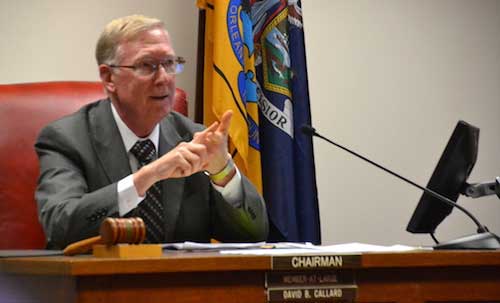Villages, towns shouldn’t expect more sales tax, Legislature chairman says

Photo by Tom Rivers: Orleans County Legislature Chairman David Callard said giving towns and villages more of the local sales tax would result in higher county property taxes.
ALBION – Orleans County legislators were asked last week to modify the sales tax sharing formula locally so towns and villages would receive a boost in funding.
Paul Lauricella of Lyndonville said the towns and villages have high tax rates and directing more local sales tax to them would help to bring down those tax rates.
“Every town and village is cash-strapped,” Lauricella told legislators during last week’s meeting. “You guys seem to have money for everything you want to do.”
The county receives about $16 million annually in sales tax and shares $1,366,671 collectively with the four villages and 10 towns. The town and village total has been frozen since 2001.
The village amount, however, has been decreasing because the local share is based partly on assessments. The town assessments have been increasing while villages have been going down.
The share for the four villages – Albion, Holley, Lyndonville and Medina – in 2013 was $404,661 of the sales tax. But it dropped by about $25,000 to 2017. The village share fell to $400,681 in 2014, to $398,111 in 2015, to $391,230 in 2016 and the biggest decrease yet, $379,265 for 2017.
“There is a limited pot of money. To take it from the county doesn’t serve any practical purposes. There is no extra sales tax money to share.” – David Callard
Legislature Chairman David Callard said he doesn’t support taking sales tax funds from the county and giving more to the towns and villages. The towns, however, could consider modifying the formula for the $1,366,671, so villages wouldn’t lose money as the assessments change.
“There is a limited pot of money,” Callard said. “To take it from the county doesn’t serve any practical purposes. There is no extra sales tax money to share.”
Village leaders periodically request the county to look at how it shares sales tax with the local municipalities, noting that in some counties, it’s more of a 50-50 split with the county getting half of the funds and cities, towns and villages sharing the other half.
Orleans, even though it keeps about 92 percent of the sales tax, is actually being generous, Callard said, because most of the 14 counties under 50,000 population don’t share any of the sales tax.
Orleans picks up some expenses that other counties push onto towns, such as community colleges. That cost has jumped for Orleans County from $694,823 in 2005 to over $1.85 million in 2017.
Callard said the county continues to be strained by mandated programs from the state, with Medicaid the biggest budget burden. If the state pulled back some of the benefits in that program, it would ease costs for the counties and state.
Lauricella said the taxes are too high locally.
Callard said the taxes would come down if the state scaled back some of benefits with Medicaid and if the state paid for more of its mandated programs.
“The best way to cut taxes would be with mandate relief,” Callard said.






































































